AAATA Secures BTC, Applauds City Council
Ann Arbor Area Transportation Authority board meeting (Nov. 21, 2013): The board’s meeting was highlighted by applause for an action taken by the Ann Arbor city council three days earlier – to give its approval to the addition of Ypsilanti Township as a member of the AAATA.

AAATA board chair Charles Griffith was interviewed after the meeting by Andrew Cluley of WEMU radio. (Photos by the writer.)
The AAATA board had already given approval to say yes to the township’s request to be added as a member – on Sept. 26, 2013. And Ypsilanti’s city council – the other recently-added jurisdiction – had given approval of the move at its Oct. 15, 2013 meeting. The Ann Arbor city council had considered the question at its Oct. 21, 2013 meeting, but had postponed action until Nov. 18, 2013.
The addition of Ypsilanti Township as an AAATA member will increase the number of positions on the AAATA board from nine to 10, with the additional member appointed by the township. Board chair Charles Griffith indicated at the Nov. 21 meeting that the name of Larry Krieg would be put forward by township supervisor Brenda Stumbo for confirmation by the township board of trustees. It’s hoped, Griffith said, that Krieg would be able to attend the next meeting of the board, on Dec. 19, as a member. Krieg attended the Nov. 21 meeting as an audience member. During public commentary at the meeting, Krieg called Ypsilanti Township’s admission into the authority a “victory for regionalism and common sense.”
In its one piece of new business on Nov. 21, the board approved an increase to the AAATA’s contract with Advance Security, to allow for around-the-clock security service coverage at the Blake Transit Center construction site. According to the staff memo accompanying the board resolution, the additional security is required until the new building can be outfitted with doors, windows and locks. The last time the board approved the annual contract it was for $205,000. The increase brought the annual value of the contract to $242,000. The BTC is now expected to be completed by the end of January 2014.
Another highlight of the meeting was a presentation on a comparative analysis the AAATA is conducting of its performance, using statistics from the National Transit Database, and a set of 20 peer transit authorities. The peer set was determined by a tool that is available through the Florida Transit Information System (FTIS). Three key metrics were presented at the Nov. 21 meeting: operating cost per service hour, rider trips per service hour, and operating cost per rider trip. While the AAATA’s operating cost per service hour is greater than its peer group average, according to the AAATA that’s counterbalanced by the number of rider trips per service hour – which leads to a lower cost per rider trip than its peer group average. In this report, The Chronicle presents that data as well as examples of other kinds of data that can be compared across the peer group.
The AAATA board also gave some discussion to a recent presentation given to its planning and development committee from Michigan Dept. of Transportation (MDOT) staff on plans for US-23. MDOT intends to use an Active Traffic Management (ATM) system to direct traffic and decrease congestion in the US-23 corridor – because there’s no funding to add an additional lane. That’s hoped to be implemented by 2016. The ATM system would involve upgrading the median shoulder, installing intelligent transportation system (ITS) equipment, constructing crash investigation sites and periodically using shoulders as travel lanes. The plan will also include widening three bridges from North Territorial Road to Eight Mile Road. The AAATA has been asked by MDOT to consider providing park-and-ride service from those bridges.
During the meeting, the board also watched a video that has been produced to explain the connector study – an alternatives analysis for the corridor running from US-23 and Plymouth southward along Plymouth to State Street, then further south to I-94. The alternatives analysis phase will result in a preferred choice of transit mode (e.g., bus rapid transit, light rail, etc.) and identification of stations and stops. The study has winnowed down options to six different route alignments.
At its Nov. 21 meeting, the board also heard its usual range of reports and communications.
Urban Core Planning
The Ann Arbor city council’s Nov. 18, 2013 vote to approve Ypsilanti Township as a member of the AAATA was mentioned at several points during the AAATA board meeting. The admission of Ypsilanti Township comes in the context of a plan to increase transportation service in the member jurisdictions – the cities of Ann Arbor and Ypsilanti and Ypsilanti Township – likely through a millage that voters would be asked to approve sometime in 2014. The current “urban core” effort is more limited in scope than a countywide effort the AAATA made in 2012. On Nov. 14, 2013, the AAATA concluded a series of 13 public meetings to explain the service plan expansion and to get feedback on it.
Urban Core: Ypsi Twp. Membership
During his report to the board, CEO Michael Ford noted that the Ann Arbor city council had voted unanimously to approve the admission of Ypsilanti Township to the AAATA. Ford’s announcement drew applause. He called Ypsilanti Township’s admission to the AAATA a “critical development” in the urban core program and he appreciated everyone who’s been involved, thanking several AAATA staff members: Michael Benham, Mary Stasiak, Bill DeGroot, Deb Freer, and Chris White. He called it a team effort. Ford also extended his appreciation to Ypsilanti Township supervisor Brenda Stumbo and clerk Karen Lovejoy Roe for their diligence and support throughout the process.
During question time, board chair Charles Griffith echoed the thanks to AAATA staff on the Ypsilanti Township membership question. He also thanked members of the Ann Arbor city council. He said he took his “hat off to Ward 3 city councilmember Stephen Kunselman, who promised he’d help shepherd it through. Congratulations to everybody for getting that done.” Griffith also recognized the extra time and work that staff had put into the series of 13 public meetings. Griffith said he was eager to hear the compilation of all the comments, and the possible revisions that the AAATA might want to consider.
The likely AAATA board appointee from Ypsilanti Township is Larry Krieg. Krieg serves on the Ypsilanti Township planning commission, writes the blog Wake Up, Washtenaw!, and has addressed the AAATA board advocating in support of various transit initiatives over the last few years.
During public commentary at the start of the meeting, Krieg thanked AAATA staff who did the presentations on the urban core plan: Michael Benham, Chris White and Deb Freer. He said they’d been very diligent and well organized. The addition of Ypsilanti Township to the AAATA was a “victory for regionalism and common sense.” Having a concern about where people come from and where they’re going is not really something that will create a vibrant economic region, he said. No one community’s government in the county or in the region is sufficient to build up the kind of economy that’s needed, he said. He was glad that the AAATA is working to bring the county and the region together.
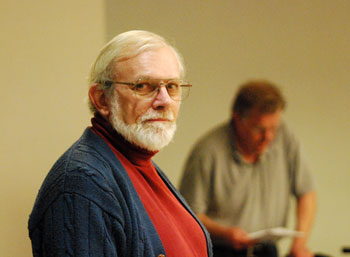
Larry Krieg, who is the likely appointee to the Ann Arbor Area Transportation Authority board from Ypsilanti Township.
Following up on Krieg’s commentary, board chair Charles Griffith noted that Krieg had been nominated to represent Ypsilanti Township on the AAATA board. Griffith hoped Krieg would be sitting with the board in the near future. CEO Michael Ford noted during his report to the board that he hoped Krieg would be sitting at the board table at the board’s next meeting, on Dec. 19.
Ford had asked Krieg before the meeting started: “Will I look forward to seeing you soon?” Krieg told Ford that he’d been nominated by Ypsilanti Township supervisor Brenda Stumbo, but that the appointment would still need confirmation by the board of trustees. Krieg told The Chronicle that Stumbo has checked about potential conflicts between Krieg’s service on the AAATA board and Krieg’s service on the citizens advisory committee of the southeast Michigan Regional Transit Authority (RTA). Indications based on inquiries through Dennis Schornack – who is senior advisor to Gov. Rick Snyder on transportation strategy and provides staff support for the RTA – were that there would not be any conflict.
Urban Core: 5-Year Plan
During his report to the board, Ford said that feedback on the urban core “listening tour” – a series of 13 public meetings held from mid-October to mid-November – was being compiled. Updates to the 5-year plan would be made where they make sense and where they’re appropriate, Ford said. He also reported that a community survey that had begun in late October was nearing completion. Among the questions being asked include questions about specific services and the willingness of survey respondents to support transit services financially. An issues analysis is being prepared for the board to consider, Ford said, which would include the 5-year plan, funding, survey data, peer review, and equity analysis, including Title VI analysis. That analysis would first be presented to the standing committees and then at some point to the full board.
During public commentary at the start of the meeting, Jim Mogensen noted that during the AAATA’s series of public engagement meetings that were held over the last month, there’d been a lot of focus on making sure that the people in the urban core are “paying their way.” So he drew the board’s attention to the suggestion from MDOT for the AAATA to serve park-and-ride lots between North Territorial and Eight Mile Road on US-23 and the idea of paying for buses out of the millage. He felt those were issues that needed to be made very clear in the AAATA’s 5-year plan.
During public commentary at the conclusion of the meeting, Mogensen responded to the idea that an issues analysis on the 5-year plan would come before the board. Alluding to the Title VI analysis, he suggested that when you increase service, the AAATA won’t have a problem. But what happens if the AAATA doesn’t increase the service because the millage doesn’t happen. He wanted that scenario to be a part of the analysis.
When Sue Gott reported out from the planning and development committee, she noted that the committee had received some public comment at that meeting expressing appreciation for the series of public engagement meetings.
That’s reflected in minutes from the Nov. 12, 2013 PDC meeting, which include the following:
Vivienne Armentrout stated she had attended one of the public meetings about proposed service improvements for the Five Year Transit Improvement Program and said they were very well organized. The meeting she attended was interactive and encouraged dynamic discussion between the presenters and the meeting attendees.
Gott agreed that the urban core meetings had been very well managed.
Blake Transit Center
The new Blake Transit Center, currently under construction on Fifth Avenue across from the downtown location of the Ann Arbor District Library, factored into the board’s discussion in more than one way. The board got a construction update, handled an item on increased security during the final construction phase, and received an update on the upcoming sale of the city-owned property just south of the BTC.
BTC: Construction
During his report to the board, CEO Michael Ford said that just before the board meeting, some of the board members and he had taken a quick tour of the under-construction Blake Transit Center. A lot of progress is being made, he said, but there’s obviously a lot more work to do. Ford said that AAATA maintenance manager Terry Black had to leave the tour he was leading to attend to a power outage at the AAATA main headquarters on S. Industrial Highway, which was affected by an area-wide outage in the southern part of town. The AAATA is moving forward with portable trailers to serve the function of the old BTC, which was demolished in early November. The new building is supposed to be finished by the end of January 2014.
During question time, Charles Griffith, who’d been along on the tour, said it was pretty fun to see that new building take shape. It’s possible now to imagine what it’s going to be like for passengers. He’s looking forward to the facility being open.
BTC: Security
The board considered an increase of the $205,000 annual contract with Advance Security, authorized by the board at its April 19, 2012 meeting, to bring the annual value of the contract to $242,000.
The increase will allow for around-the-clock security service coverage at the Blake Transit Center construction site. According to the staff memo accompanying the board resolution, “This additional security service is required until the installation of doors, windows and locks has been completed on the new building to help prevent trespassing, vandalism, loitering, etc.”
That increase in the contract amounts to 18%. Under the AAATA procurement policy, increases of contracts over 10% require board approval. That’s why it was before the board on Nov. 21, 2013. When the board approved the $205,000 in April 2012, that was for the fourth year of a contract first authorized by the board on March 19, 2009 for one year. That contract increase came before the board because it increased the amount of the contract from the previous year by more than 10% – from $150,000 to $205,000, or 36.7%. That new contract was based on hourly wages between $14.33 and $19.67 per hour for a regular shift, and between $21.50 and $29.51 for extra hours and holidays.
The April 2012 increase in the Advance Security contract was based on the need to make the hourly wages in the contract meet the city of Ann Arbor living wage standard, which was adopted by the AATA board at its June 16, 2011 meeting.
The increase the board was asked to approve at its Nov. 21 meeting was for $30,000. The living wage policy had previously increased the amount from $205,000 to $212,000 – an amount that did not require board approval.
BTC: Security – Deliberations
In reporting out from the performance monitoring and external relations (PMER) committee, Roger Kerson noted that the committee had reviewed one action item: the increase in the security contract. “We basically need more people watching the [BTC] project.” About the extra expense, Kerson said, “We kinda need to spend the money.” He also pointed out that the AAATA’s security expenses have gone up considerably because of the living wage. That means the AAATA is spending more on people at the lower end of the compensation scale – for the security contract and likely for the janitorial contract as well.
When the board came to the item, Charles Griffith noted that the board had heard during committee reports the rationale for the need to change the contract. The board voted without further deliberations.
Outcome: The board voted unanimously to approve the Advance Security contract increase.
During public commentary at the start of the meeting, Jim Mogensen told the board he’d worked on the living wage campaign in Ann Arbor 14 years ago when that effort was made, so he was glad that the AAATA had adopted the city’s living wage ordinance. He drew the board’s attention to the fact that one of the citations of the actual wage likely had a typo in it.
BTC: Dahlmann, Y Lot
During his report to the board, CEO Michael Ford noted that in the context of the city council’s action to approve a sales agreement with Dennis Dahlmann for the old Y lot downtown – which is just south of the Blake Transit Center – board chair Charles Griffith would be assigning a subcommittee to work with Dahlmann. Ford noted that the rider agreement included a requirement that Dahlmann work with the AAATA toward its goal of not using on-street areas for bus boardings. From the rider agreement:
Discussion with AAATA. Purchaser agrees to discuss with the Ann Arbor Area Transportation Authority (the “AAATA”). in good faith whether the Purchaser can help facilitate AAATA’s goal of limiting on-street bus transit and/or storage on Fifth and William within the immediate area of Blake Transit Center. This covenant shall survive Closing.
Ford said he looked forward to working with Dahlmann to meet “our collective goals.”
MDOT: US-23
During his report to the board, CEO Michael Ford noted that the planning and development committee (PDC) had received a presentation from MDOT staff on improvements on US-23 between North Territorial to Eight Mile Road. [Former AAATA board member Paul Ajegba was one of two MDOT staffers who gave the presentation.]
MDOT intends to use an Active Traffic Management (ATM) system to direct traffic and decrease congestion in the US-23 corridor – because there’s no funding to add an additional lane. That’s hoped to be implemented by 2016. The ATM system would involve upgrading the median shoulder, installing intelligent transportation system (ITS) equipment, constructing crash investigation sites and periodically using shoulders as travel lanes. The plan will also include widening three bridges from North Territorial Road to Eight Mile Road.
The AAATA has been asked by MDOT to consider providing park-and-ride service from those bridges. Ford said the AAATA would be considering that request to see how it fits into the AAATA’s work plan.
Sue Gott reported out from the planning and development committee that the committee had spent quite a bit of time discussing the MDOT presentation, to understand the type of modeling that had been done by MDOT to identify the congested nature of US-23 and how the proposed use of the shoulders addresses congestion management. Gott felt there was an understanding that AAATA staff would follow up with MDOT about the potential for AAATA to be a partner for construction and operation of a new park-and-ride lot to be located along the corridor. Gott looked forward to more feedback from staff about the traffic modeling and the benefits and the opportunities for thinking about an HOV (high-occupancy vehicle) lane – allowing there are some state restrictions on HOV lanes. She concluded that there was some opportunity, and that the Washtenaw Area Transportation Study (WATS) would also be looking at this issue.
In reporting out from the PMER committee, Roger Kerson commented on the presentation that the committee had received from MDOT about US-23. He ventured that MDOT is not going to re-do the exit ramps twice. “If you wanted to have a park-and-ride near one of those spots,” Kerson said, “this is the time to do it.” On the other hand, the AAATA has the urban core initiative and the connector project going on. He characterized the US-23 project as intruding on the AAATA’s agenda, even if it’s not in AAATA’s plan – because MDOT can proceed with its project on its own. “It’s their road. If they want to not widen it, but make it wider, they can!” he quipped.
During question time, Kerson said he wanted to throw on the table a timeline for the AAATA to interact with MDOT’s US-23 project. His sense from MDOT is they have a schedule – so he thought that as an organization the AAATA board needs to spend some time thinking about it. A park-and-ride is not a part of any of AAATA’s recent plans, but it’s an opportunity to do it in an efficient way – with MDOT willing to contribute land acquisition. One concern, which Anya Dale had raised at the committee meeting, is that it’s making individual vehicle operation and travel easier. So it’s not clear if setting up a park-and-ride lot at that location is the AAATA’s best action, Kerson said.
Kerson wanted some time to reflect on what it is that the AAATA wants to do. It raises a lot of questions that he didn’t know the answers to. Ford said there are some additional parties that he wants to talk to. Staff is putting together some information for the board. Ford recognized it’s a “meaty issue.”
Charles Griffith ventured there is already a park-and-ride lot at the North Territorial interchange. Responding to Griffith, Chris White explained that there’s a distinction between a carpool lot and a park-and-ride lot. Griffith wondered if MDOT would not be seriously considering rebuilding the carpool lot anyway. He was curious to know how dependent MDOT’s decisions would be on a decision by AAATA to serve that lot. Griffith noted that the lot is well used, saying he uses it himself on trips to Lansing, when he carpools with colleagues.
Connector Study
The board got an update on the connector study – an alternatives analysis for the corridor running from US-23 and Plymouth southward along Plymouth to State Street, then further south to I-94. The alternatives analysis phase will result in a preferred choice of transit mode (e.g., bus rapid transit, light rail, etc.) and identification of stations and stops. The study has winnowed down options to six different route alignments.
The board also watched a video that has been produced to explain the project. Later in the meeting Roger Kerson asked who had produced the video. Community relations manager Mary Stasiak indicated that it had been produced by Quack!Media.
During his report to the board, CEO Michael Ford noted that on Nov. 14 three public meetings had been held to highlight the six different potential alignments for a route and station locations. About 50 people total had attended the meetings, he said. Ford characterized most of the feedback as positive or constructive. The board was shown a 4-minute video that has been produced to explain the connector study. Spring 2014 is the timeframe for sharing the preferred alternative with the community, Ford said.
Board chair Charles Griffith said the connector study was approaching an interesting phase in selecting routes. He was eager to see some of the modeling results. From the community and business perspective, he ventured, “it’s going to change the look and feel of the city in some significant ways.” He urged the rest of the people in the community who were interested in how the city is going to look in the future to get engaged and weigh in.
During question time, Sue Gott thanked board members who were able to attend the meetings on the connector. She encouraged other board members who could not attend to take the time and effort to review the materials. She wanted the board to be engaged and to “maintain pace” with the study. Now modeling will be done and the outcome of that modeling will shape the study committee’s recommendation of a preferred alternative. The degree to which board members can stay engaged and ask questions will be very helpful, she said.
In spring 2014 that committee will be looking to make a recommendation, so it will be important for all of the AAATA board members to maintain enough connectivity to the study to be able to support the outcome, Gott said.
Disability Issues
Sue Gott reported out from the planning and development committee that the committee had begun a review of the capital and categorical grant program. They’d been assured there’s enough funding for the projects in the program. Part of paratransit improvements would include purchase of buses for A-Ride instead of having the contractor provide the vehicles. AAATA currently owns six small A-Ride vehicles, but under the new capital program, AAATA would own all vehicles for the A-Ride program to increase flexibility and give the AAATA a higher level of control.
In reporting out from the PMER committee, Roger Kerson said that board member Jack Bernard had raised some issues about the AAATA website with respect to accessibility – involving selection of colors. Making sure the website is accessible would continue to be on the AAATA’s agenda, he said.
Rebecca Burke reported from the AAATA’s local advisory council (LAC), a group that provides input and feedback to AAATA on disability and senior issues. She reported that the group had met on Nov. 12. She noted that Jack Bernard had attended the meeting as the liaison from the board to the LAC. She felt that would improve communication between the board and the LAC.
Michael Benham, strategic planner for the AAATA, had given the LAC a shorter version of the 5-year improvement plan presentation, Burke said. She called the question-answer period very productive. A representative from Jewish Family Services had attended the meeting to explain their accessibility plan, and expressed an interest in providing a paratransit option in the county. The LAC had also approved a change to its bylaws to reflect the addition of the word “area” to the name of the Ann Arbor Area Transportation Authority.
Bernard followed up Burke’s remarks by calling his first meeting a really wonderful meeting. The committee had heard from citizens at the meeting, who’d come with specific stories about their experiences using the AAATA’s services. He’d found the AAATA staff to be “incredibly receptive” to hearing those experiences. He said that staff had provided good approaches to dealing with various issues. He’d gotten the impression that those who attend the meetings to share their concerns are still very happy with the service. Bernard also encouraged other board members to “stick your head into that meeting.” He felt they’d find it refreshing, and they’d see the staff interacting with passengers.
During public commentary time at the end of the meeting, Carolyn Grawi, Ann Arbor Center for Independent Living director of advocacy and education, noted that she works with and behalf of people in the community with disabilities. She said she loved the fact that the peer analysis included the paratransit service. Oftentimes people with disabilities are not included in such reports. Grawi also reported that Barrier Busters is now a member of Partners for Transit.
Peer Analysis
AAATA staffer Julia Roberts gave the board a presentation on a peer review analysis. Some of the information from the report had been presented at the final public engagement meeting for the 5-year improvement plan held on Nov. 14 at SPARK East in Ypsilanti. [.pdf of presentation slides]
To determine its peer group, Roberts explained that the AAATA had relied on a tool that is available through the Florida Transit Information System (FTIS) based on recommendations from the Transit Cooperative Research Program. The tool relies on the following criteria to establish a “likeness” index between a transit agency and other transit agencies nationwide:
- urban area population
- total annual vehicle miles operated
- annual operating budget
- population density
- percent of college students
- population growth rate
- percent service purchased
- percent low-income population
- annual delay (hours) per traveler
- freeway lane miles (thousands) per capita
- percent service demand-responsive
- distance between agencies
Based on the “likeness” index, it’s possible to select the top 20 (or any number) of other transit agencies to analyze in comparison to the AAATA. Measured on the above criteria, the most similar 20 organizations to the AAATA are transit agencies in these peer communities: Peoria, IL; Lexington, KY; Moline, IL; Lansing, MI; Syracuse, NY; Savannah, GA; Champaign-Urbana, IL; Roanoke, VA; Concord, CA; Erie, PA; Kalamazoo, MI; Harrisburg, PA; Fort Wayne, IN; Rockford, IL; Shreveport, LA; Hartford, CT; Fort Collins, CO; Scranton, PA; Gainesville, FL; and South Bend, IN.
To illustrate how the AAATA compares to that peer group, Roberts then presented charts for three key metrics for the fixed-route service: (1) operating cost per service hour; (2) rider trips per service hour; and (3) operating cost per rider trip. While the AAATA’s operating cost per service hour is greater than its peer group average, according to the AAATA that’s counterbalanced by the number of rider trips per service hour – which leads to a lower cost per rider trip than its peer group average. Using the same tool, The Chronicle was able to replicate the AAATA’s result in determining the peer group as well as the comparative analysis for those three metrics. In the charts below, the AAATA is always presented in the leftmost bar, and the other transit agencies are presented from left to right in their rank order of “likeness.”
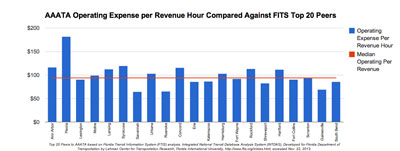
AAATA Operating Expense per Revenue Hour compared against FTIS Top 20 peers. Top 20 peers to AAATA are based on Florida Transit Information System (FTIS) analysis. Data from Integrated National Transit Database Analysis System (INTDAS), developed for Florida Department of Transportation by Lehman Center for Transportation Research, Florida International University, http://www.ftis.org/intdas.html, accessed Nov. 22, 2013.

AAATA Passenger Trips per Revenue Hour compared against FTIS Top 20 peers. Top 20 peers to AAATA based on Florida Transit Information System (FTIS) analysis. Data from Integrated National Transit Database Analysis System (INTDAS), developed for Florida Department of Transportation by Lehman Center for Transportation Research, Florida International University, http://www.ftis.org/intdas.html, accessed Nov. 22, 2013.
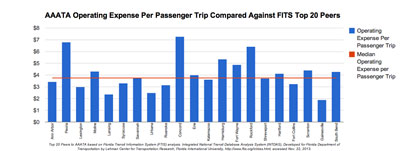
AAATA Operating Expense per Trip compared against FTIS Top 20 peers. Top 20 peers to AAATA based on Florida Transit Information System (FTIS) analysis. Data from Integrated National Transit Database Analysis System (INTDAS), developed for Florida Department of Transportation by Lehman Center for Transportation Research, Florida International University, http://www.ftis.org/intdas.html, accessed Nov. 22, 2013.
The Chronicle performed additional comparative analyses on the same peer group set. The average headway – a measure of how frequent the service runs – shows that the AAATA provides service more frequently than its peer group. A lower number indicates more frequent service:
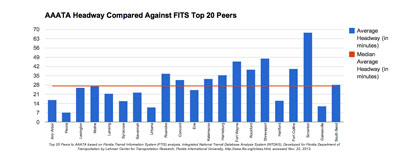
AAATA Average Headway compared against FTIS Top 20 peers. Top 20 peers to AAATA based on Florida Transit Information System (FTIS) analysis. Data from Integrated National Transit Database Analysis System (INTDAS), developed for Florida Department of Transportation by Lehman Center for Transportation Research, Florida International University, http://www.ftis.org/intdas.html, accessed Nov. 22, 2013.
The AAATA’s buses are slightly newer than its peer group’s buses:
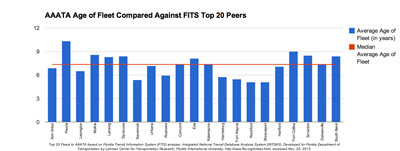
AAATA Average Age of Fleet compared against FTIS Top 20 peers. Top 20 peers to AAATA based on Florida Transit Information System (FTIS) analysis. Data from Integrated National Transit Database Analysis System (INTDAS), developed for Florida Department of Transportation by Lehman Center for Transportation Research, Florida International University, http://www.ftis.org/intdas.html, accessed Nov. 22, 2013.
AAATA buses have slightly better than average fuel consumption, measured against its peer group:

AAATA Miles per Gallon compared against FTIS Top 20 peers. Top 20 peers to AAATA based on Florida Transit Information System (FTIS) analysis. Data from Integrated National Transit Database Analysis System (INTDAS), developed for Florida Department of Transportation by Lehman Center for Transportation Research, Florida International University, http://www.ftis.org/intdas.html, accessed Nov. 22, 2013.
The AAATA provides fewer route miles of service per square mile of its service area compared to its peer group:
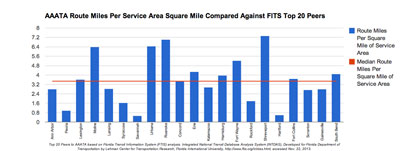
AAATA Route Miles Per Square Mile of Service Area compared against FTIS Top 20 peers. Top 20 peers to AAATA based on Florida Transit Information System (FTIS) analysis. Data from Integrated National Transit Database Analysis System (INTDAS), developed for Florida Department of Transportation by Lehman Center for Transportation Research, Florida International University, http://www.ftis.org/intdas.html, accessed Nov. 22, 2013.
The AAATA spends very close to its peer group average on maintenance per mile of service:
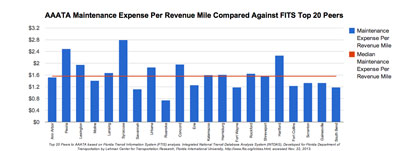
AAATA Maintenance Expense per Revenue Mile compared against FTIS Top 20 peers. Top 20 peers to AAATA based on Florida Transit Information System (FTIS) analysis. Data from Integrated National Transit Database Analysis System (INTDAS), developed for Florida Department of Transportation by Lehman Center for Transportation Research, Florida International University, http://www.ftis.org/intdas.html, accessed Nov. 22, 2013.
The AAATA buses travel about the same as its peer group average before they break down:
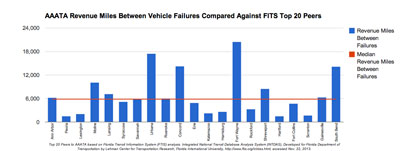
AAATA Revenue Miles Between Vehicle Failures compared against FTIS Top 20 peers. Top 20 peers to AAATA based on Florida Transit Information System (FTIS) analysis. Data from Integrated National Transit Database Analysis System (INTDAS), developed for Florida Department of Transportation by Lehman Center for Transportation Research, Florida International University, http://www.ftis.org/intdas.html, accessed Nov. 22, 2013.
The AAATA has about the same farebox recovery ratio as the average of its peer group:
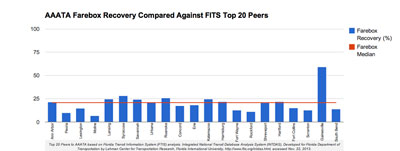
AAATA Farebox Recovery compared against FTIS Top 20 peers. Top 20 peers to AAATA based on Florida Transit Information System (FTIS) analysis. Data from Integrated National Transit Database Analysis System (INTDAS), developed for Florida Department of Transportation by Lehman Center for Transportation Research, Florida International University, http://www.ftis.org/intdas.html, accessed Nov. 22, 2013.
The AAATA provides more passenger trips per employee than its peer group average:
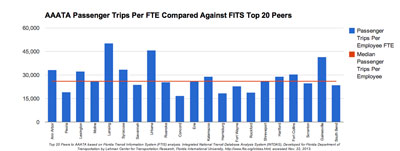
AAATA Trips per FTE compared against FTIS Top 20 peers. Top 20 peers to AAATA based on Florida Transit Information System (FTIS) analysis. Data from Integrated National Transit Database Analysis System (INTDAS), developed for Florida Department of Transportation by Lehman Center for Transportation Research, Florida International University, http://www.ftis.org/intdas.html, accessed Nov. 22, 2013.
Roberts also presented data from the AAATA’s paratransit operation: operating expenses per service hour, rides per service hour and operating expense per service hour. Whereas its fixed route service shows significantly more trips per service hour compared to the peer group average, the AAATA’s paratransit service provides about 20% fewer rides per service hour than the peer group average. Roberts said that this is countered by the fact that AAATA provides more than twice as many service hours and service miles than its peer group average.
In concluding the presentation, Roberts noted that the AAATA carries about 6 million passengers annually – or 50% more passengers per service hour than its peer median. The AAATA’s fiscal performance is strong, she said, and the AAATA’s commitment to quality is “unwavering.” One of the highest priorities of management is to “control operating expenses, while meeting increasing ridership demands,” she said. So the AAATA would keep working to identify and implement efficiencies to reduce costs.
Peer Analysis: Board Discussion
Commenting on the peer group comparative analysis, Sue Gott asked that the presentation be emailed to board members. Jack Bernard asked how the peer data helped identify what the AAATA should focus on. “What does that peer data tell us that we want to work on next?” He wanted to know how the peer review sets the AAATA’s trajectory and agenda for the future.
Eric Mahler said he also thought the peer review was very helpful. He was curious to know about additional financial metrics: How does the AAATA compare on overall financial health?
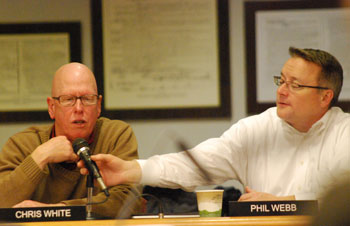
From left: AAATA manager of service development Chris White and controller Phil Webb. Webb was turning on White’s microphone, so that his remarks would be picked up by the CTN recording.
Some back-and-forth between Michael Ford and Mahler focused on what kind of information Mahler wanted. Manager of service development Chris White noted that the National Transit Database doesn’t include balance sheets. He was not sure that the NTD would provide an indication of overall financial health.
Controller Phil Webb indicated that when he thinks about overall financial health, he thinks in terms of reserves, debt structure, working capital and that kind of information. It would require looking at the audits of each transit organization.
The comparables could be a little tricky depending on what kind of accounting those agencies used. Mahler said he didn’t want to create extra work for anyone. If it was already part of the study, then he’d wanted that to be included. Charles Griffith also expressed interest in seeing a more detailed report on the comparative analysis
Communications, Committees, CEO, Commentary
At its Nov. 21 meeting, the board entertained various communications, including its usual reports from the performance monitoring and external relations committee, the planning and development committee, as well as from CEO Michael Ford. The board also heard commentary from the public. Here are some highlights.
Comm/Comm: RTA
During his report to the board, CEO Michael Ford noted that Richard “Murph” Murphy will not be seeking another board term on the Southeast Michigan Regional Transit Authority. That position is expected to be filled by the end of the calendar year, Ford said. It’s an appointment made by the chair of the Washtenaw County board of commissioners, Yousef Rabhi.
Comm/Comm: Financial Report
In reporting out from the PMER committee, Roger Kerson said the financial reports had some typical first-quarter anomalies, and the AAATA was a little bit under its reserves. But that was expected to be straightened out in the next few months, Kerson said.
Comm/Comm: Ridership
In reporting out from the PMER committee, Roger Kerson noted that ridership is now looking flat compared to a year ago – as compared to the steady increases that had been seen previously. Kerson said Chris White’s best guess was that it had something to do with gas prices – because they are not as high as they were last year. Kerson noted that the AAATA had not lost riders when gas prices went down, which to him indicated that you keep the riders you attract due to increased gas prices.
During his report to the board, CEO Michael Ford noted that the AirRide service to Detroit Metro Airport was averaging over 1,200 riders per week in the last five weeks. On Nov. 15 an additional trip had been added, bringing the total to 13 round trips daily, Ford said.
Comm/Comm: Birthdays
During public commentary, Jim Mogensen bridged a four-decade span by highlighting a city council resolution from 1970 congratulating Jerry Lax, who was Ann Arbor city attorney at the time, on his birthday. Mogensen noted that Lax had attended the city council’s Nov. 18 meeting – as the AAATA’s legal counsel – and that had reminded him of the resolution, which he had in his files. Mogensen read aloud the resolution.
Comm/Comm: Partridge
During public commentary at the start of the meeting, Thomas Partridge addressed the board. He asked for board leadership in removing discrimination and poor performance and “outright incompetence” in operation of AAATA programs like the senior ride program and the A-Ride program – the AAATA’s paratransit programs. Those programs have been long-standing sources of neglect, abuse and discrimination, he contended. He’d called for such reforms at several meetings over several years. But the contractor is still sending out vehicles that shouldn’t be on the road and drivers with questionable ability and poor attitudes, he claimed.
During public commentary at the end of the meeting, Partridge recalled that 50 years ago in November 1963, he was doing homework as a Michigan State student with the expectation of a good November weekend – an expectation that was upset with the assassination of president John F. Kennedy. He had come into office with high spirits and energy. Kennedy had called on everyone to contribute, Partridge said, and had declared that a torch had been passed to a new generation. Partridge wanted us to live up to Kennedy’s vision.
Present: Charles Griffith, Eric Mahler, Sue Gott, Roger Kerson, Anya Dale, Gillian Ream Gainsley.
Absent: Susan Baskett, Eli Cooper.
Next regular meeting: Thursday, Dec. 19, 2013 at 6:30 p.m. at the fourth-floor boardroom of the Ann Arbor District Library’s downtown location, 343 S. Fifth Ave. [Check Chronicle event listing to confirm date]
The Chronicle could not survive without regular voluntary subscriptions to support our coverage of public bodies like the Ann Arbor Area Transportation Authority. Click this link for details: Subscribe to The Chronicle. And if you’re already on board The Chronicle bus, please encourage your friends, neighbors and colleagues to help support The Chronicle, too!




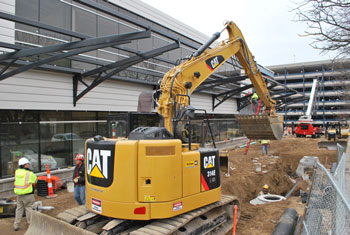
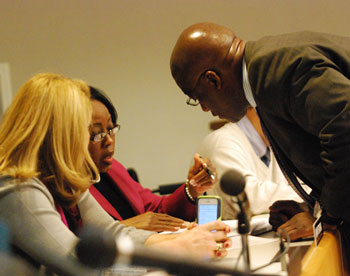

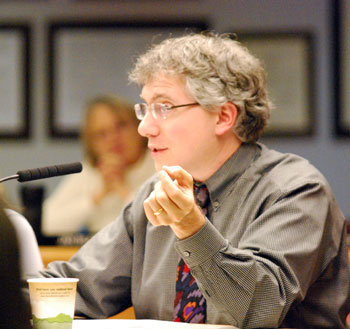
The 17 minute average headway seems low to me, considering most buses run every half hour during the day, and every hour evenings and weekends.
Regarding the MDOT proposal, I was present at the PDC meeting where the presentation was made. It was my impression that there is a certain amount of pushback based on the wish by some that MDOT would put money into WALLY instead of the highway. This was actually addressed in one slide of the presentation, which stated that the two can operate concurrently. Mark Sweeney from MDOT said at one point that WALLY could account for 1,500 passengers (one way) but average daily traffic on US 23 (one way) is 33,000.
This post [link] enunciates the competition between these two solutions to the congestion on US23.
Personally, I would think that the one-time investment in new Park and Ride lots would be worthwhile. But it would mean a significant service expansion for AAATA to run buses up US23 to those lots, not a trivial decision. Still, if the objective is to reduce automobile flow into Ann Arbor (especially down Main Street), it seems worthy of a second thought, at least.
In terms of future Park and Ride lots, the AAATA’s master plan should be adaptable when certain opportunities arise like free land along US23.
The Main Street rush hour backup which occurs every evening not only inconveniences the commuters heading north, but the city residents trying to get across town. The situation is only getting worse and as Vivienne points out, WALLY would only divert about 5% of the current traffic count.
Now is the time for the AAATA to be reaching out to UM and Northfield Twp. to see if there is any interest in partnering up for a new route up either US23 and/or Whitmore Lake Rd. UM is helping subsidize the Canton route so why not help out their employees coming in from the north as well?
Also, consider expanding the AirRide schedule again to accommodate a few stops along US23 at the new Park and Ride lots? This could help commuters going to either Lansing or Ann Arbor!
I still can’t fathom why UM, and especially the UM Medical Center, wouldn’t look into the practicality of operating coaches to bring in their employees from Livingston County and elsewhere. From my observation, a large portion of the rush hour traffic between Main and M-14 consists of UM hospital employees, a fair number of whom already use the vanpools. Why not just step this up to another level? THe coaches would use existing road infrastructure, perhaps combine some vanpools (opening up parking spaces for visitors and patients), and in theory, save UM from having to build more expensive and ugly parking structures.
Of course, the ideal, “sustainable” solution would be for UM to build (or partner with a private developer to build) housing for employees that would be close enough to the medical center that the only commute would be a short walk.
Re: the idea of UM operating longer-distance coaches for its employees
The efforts of Google and other tech firms in the San Francisco area to provide motor coaches for their workers have been so successful that they’ve generated a certain amount of pushback (e.g., because they take up space at the public transportation bus stops, where they also pick up passengers.) [link] But those efforts do seem to demonstrate the viability of the concept. [link] And I would think that by studying what works and what doesn’t in SF, and what’s different between the SF context and ours, UM might use that approach to take a bite out of the problem.
Re: the idea of UM operating longer-distance coaches for its employees
I should have also included this new shuttle to Detroit that UM is operating as part of the mix: [link]